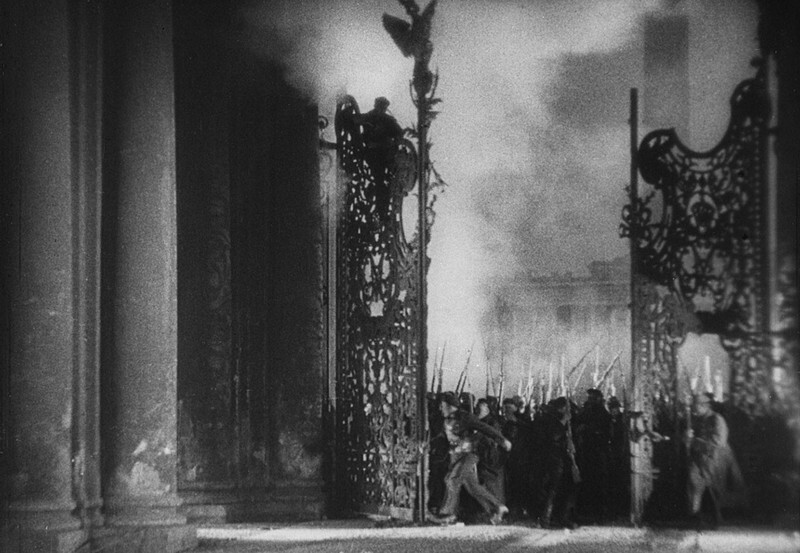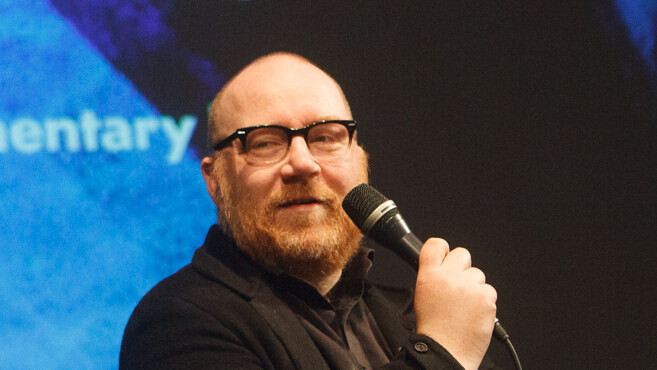Lenin: Icon
This section explored the way in which one of the most important political events of the 20th century – which left few original cinematic records – was recreated on film. Our first images of the storming of the Winter Palace come from Evreinov’s theatrical spectacle with thousands of extras from 1920, and today his film is often erroneously considered a historical record of the actual events.
It is only with the tenth anniversary of the revolution that Soviet cinema began to intensively focus on depicting this cornerstone of Soviet ideology. Production was organized by a special anniversary commission of the Central Executive Committee of the Soviet Union. Their efforts resulted in the creation of three first-class films. Sergei Eisenstein concluded his revolutionary trilogy with October: Ten Days that Shook the World (1927), which despite its ideological loyalty to the Stalinist regime is an exemplary catalogue of pioneering directorial techniques. Esfir Shub, the first lady of Soviet cinema and an outstanding editor and documentarian, created the propagandistic film epic The Fall of the Romanov Dynasty (1927). Only fragments have survived of Boris Barnet’s Moscow in October (1927), in which Lenin (as in Eisenstein’s film) was played by the steelworker Vasili Nikandrov, who was the spitting image of the great revolutionary leader.
The next wave of Stalinist interpretations of the revolution and its leading figure, though now deprived of the sagacity of the 1920s, is personified primarily by Mikhail Romm. His two epics Lenin in October (1937) and Lenin in 1918 (1939) were later subjected to censorship that reduced Stalin’s presence in the films – in 1963, the dictator was turned into a streetlight standing next to Lenin. Lenin was played by Boris Shchukin, a student of the great modernist theatre director Yevgeny Vakhtangov. Today, Shchukin’s name graces one of Moscow’s most renowned acting schools – the Boris Shchukin Theatre Institute, known colloquially as the Shchuka. But the most popular Lenin of postwar Soviet cinema was Yuriy Kayurov, who played Lenin in eighteen films, including The Sixth of July (1968), named after the date of the 1918 Left SR uprising put down by the Bolsheviks. The film was directed by the capable but unexceptional Yuli Karasik, but it is noteworthy for the music by the legendary post-avant-garde composer Alfred Schnittke.
Even in the waning days of the Soviet Union, the country’s film industry continued to depict the founding myths of the Soviet state. One such project was by actor and director Sergei Bondarchuk, best known for his four-part screen adaptation of War and Peace (1965–1966). Bondarchuk’s epic, the big-budget film Red Bells II (1982), saw the return to the screen of several previously banned revolutionaries and later victims of the Stalinist terror: Leo Trotsky, Grigory Zinoviev and Lev Kamenev.
During the post-Soviet era, Russian cinema tried to come to terms with the criminal brutality of the Cheka/NKVD/KGB/FSB, as for instance the author of the later series of comedies about the peculiarities of national hunting Alexander Rogozhkin (The Chekist, 1991). Filmmakers also created a large number of documentaries on the Bolshevik revolution .
But the film that met with the greatest response, Alexander Sokurov’s Taurus, did not look directly at the revolution. Instead, it explored the fanatical struggle for power. It does not depict the cult of the charismatic revolutionary, the communists’ obsession with manipulating the masses or the violence of fired-up mobs; instead, its subject is the other side of this bloody tale. With Sokurov, the revolution is the past. The story is set in the summer of 1923 at Lenin’s dacha in Gorky, when the leader of the Soviet proletariat is weak and near death. Paralyzed and confined to a wheelchair, he is the victim of the cold-blooded machinations and manipulation of those around him.
Czechoslovak films about the 1917 revolution and its leader represent a separate chapter in this story. Lenin’s pre-revolutionary 1912 visit to Prague was twice portrayed in film – in documentary filmmaker Drahoslav Holub’s 14-minute short Lenin in Prague (1951) and in Jan Kavan’s eponymous film from 1970. Soviet subjects were more commonly portrayed on television – in the 1980s, Czechoslovak TV produced two adaptations of plays by Nikolai Pogodin (which had also been adapted for film in the USSR): The Kremlin Chimes (dir. Evžen Sokolovský, 1977 and 1982) and Man with a Gun (dir. Jan Matějovský, 1988). In both works, the main character was played by the Normalization-era head of the National Theatre’s drama department and communist lecturer Václav Švorc.
Besides looking at Evreinov, Eisenstein and Sokurov, the section has been conceived as a commented collage of important excerpts of the various films.


